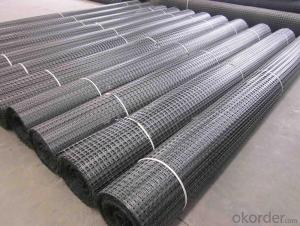Uniaxial Geogrids - HDPE High Tensile Strength for Retaining Walls/Road Construction
- Loading Port:
- Qingdao
- Payment Terms:
- TT or LC
- Min Order Qty:
- 5000 m²
- Supply Capability:
- 1200000 m²/month
OKorder Service Pledge
OKorder Financial Service
You Might Also Like
1. Description of High Tensile Strength HDPE Uniaxial Plastic Geogrid for Retaining Wall/Road Consturction
The geogrid is a high strength geosynthetics, is made of high density polyethylene (HDPE) as raw materials, pressure into a sheet by extrusion and then punching network rules, and then the longitudinal tensile and geogrid.
2. Properties of High Tensile Strength HDPE Uniaxial Plastic Geogrid for Retaining Wall/Road Consturction
High stength
Good fiexibility
Anti-aging
homogenous stucture
Resisting acid and alkaline
Easy for constrution etc.
3. Specifications of High Tensile Strength HDPE Uniaxial Plastic Geogrid for Retaining Wall/Road Consturction


4. Application of High Tensile Strength HDPE Uniaxial Plastic Geogrid for Retaining Wall/Road Consturction
All kinds of soft soil foundation reinforcement treatment
Strengthen the embankment
Improve bearing capacity of the subgrade
Stress state of retaining wall, slope, dam, bridge abutment reinforcement,
Improve project quality, prolong the service life of the project.
5. Photos of High Tensile Strength HDPE Uniaxial Plastic Geogrid for Retaining Wall/Road Consturction


6. RFQ
1) What's your payment terms?
Our usual payment terms is T/T, L/C at sight or others as your request
2) What's your delivery time?
Within 15days against your prepayment received or original L/C.
3) Can you send samples in freely?
Yes, we can send free samples totally for your testing.
- Q: What is a geogrid?
- A geogrid is a type of geosynthetic material that is used to reinforce soil or other materials in civil engineering applications. It is typically made of polymer materials and has a grid-like structure that provides tensile strength and enhances the stability of the soil or other materials it is placed within.
- Q: Are geogrids suitable for reinforcement of mechanically stabilized aggregate layers?
- Yes, geogrids are suitable for reinforcement of mechanically stabilized aggregate layers. Geogrids are designed to enhance the load-bearing capacity and stability of soil or aggregate layers. They can effectively distribute and transmit load forces, improving the overall performance and longevity of mechanically stabilized aggregate layers.
- Q: Longitudinal and transverse tensile strength more than 60kn/m which has several geogrid
- The ultimate tensile strength of geogrid from high to low in the order of glass fiber geogrid, geogrid, plastic geogrid, and ultimate elongation from high to low in the order of warp knitting, plastic grille grille (extension rate of raw materials as a warp knitted grill has a larger change range, some may be more than a small plastic grille), glassgrid. Glass fiber grille without creep.
- Q: How much investment is needed for the grid cloth on the production site
- The mesh cloth is made of alkali or alkali free glass fiber yarn, which is coated with alkali resistant polymer emulsion. Mesh cloth series products: alkali resistant GRC fiberglass mesh cloth, alkali resistant wall mesh and stone mesh cloth, marble back mesh cloth.
- Q: What is the lowest price of two-way plastic geogrid?
- You need to look at how much the kn
- Q: Definition of GeotextilesWhat are what material, what role
- Geotextiles and geotextile, which is permeable geosynthetic materials made of synthetic fiber by acupuncture or woven cloth. The finished product is the general shape, width of 4-6 meters, the length of 50-100 meters. Geotextiles are divided into nonwoven geotextiles and geotextile geotextile. The cloth has excellent filtration, isolation, reinforcement and protection function, high tensile strength, good permeability, high temperature resistance, anti freezing, aging resistance, corrosion resistance.
- Q: What are the specifications of fiberglass geogrid for Asphalt Pavement
- 50KN is a relatively large number of glass fiber, of course, also depends on the road re design of the standard is to determine what the specifications,
- Q: Can geogrids be used in reinforced earth structures?
- Yes, geogrids can be used in reinforced earth structures. Geogrids are commonly used to reinforce soil and provide stability in various civil engineering applications, including reinforced earth structures. They are designed to distribute load and improve the overall strength and performance of the structure.
- Q: What is the name of the geotextile woven from polyester and polyester threads?Should be with a flat woven out, like polyester yarn is double stranded and
- Generally speaking two nouns can be used in generalThe earliest polyester is said polyester, the full name is "terephthalic acid two polyethylene glycol ester". Later, the type of polyester fiber gradually expanded, many also known as modified polyester
- Q: Polypropylene geogrid and plastic geogrid
- Not the same, plastic geogrid points; polyethylene, polypropylene two!
1. Manufacturer Overview
| Location | 示范:Hebei, China |
| Year Established | 示范:1997 |
| Annual Output Value | 示范:Above US$50 Million |
| Main Markets | 30.00% South America; 20.00% North America; 15.00% Eastern Europe; 15.00% Southeast Asia; 10.00% South Asia; 5.00% Southern Europe; 5.00% Africa |
| Company Certifications | ISO 9001:2008 |
2. Manufacturer Certificates
| a) Certification Name | |
| Range | |
| Reference | |
| Validity Period |
3. Manufacturer Capability
| a) Trade Capacity | |
| Nearest Port | Tianjin;Qingdao;Shanghai |
| Export Percentage | |
| No.of Employees in Trade Department | 21-50 People |
| Language Spoken: | English;Chinese |
| b) Factory Information | |
| Factory Size: | Above 100,000 square meters |
| No. of Production Lines | Above 12 |
| Contract Manufacturing | OEM Service Offered;Design Service Offered |
| Product Price Range | High;Average |
Send your message to us
Uniaxial Geogrids - HDPE High Tensile Strength for Retaining Walls/Road Construction
- Loading Port:
- Qingdao
- Payment Terms:
- TT or LC
- Min Order Qty:
- 5000 m²
- Supply Capability:
- 1200000 m²/month
OKorder Service Pledge
OKorder Financial Service
Similar products
Hot products
Hot Searches
Related keywords
































